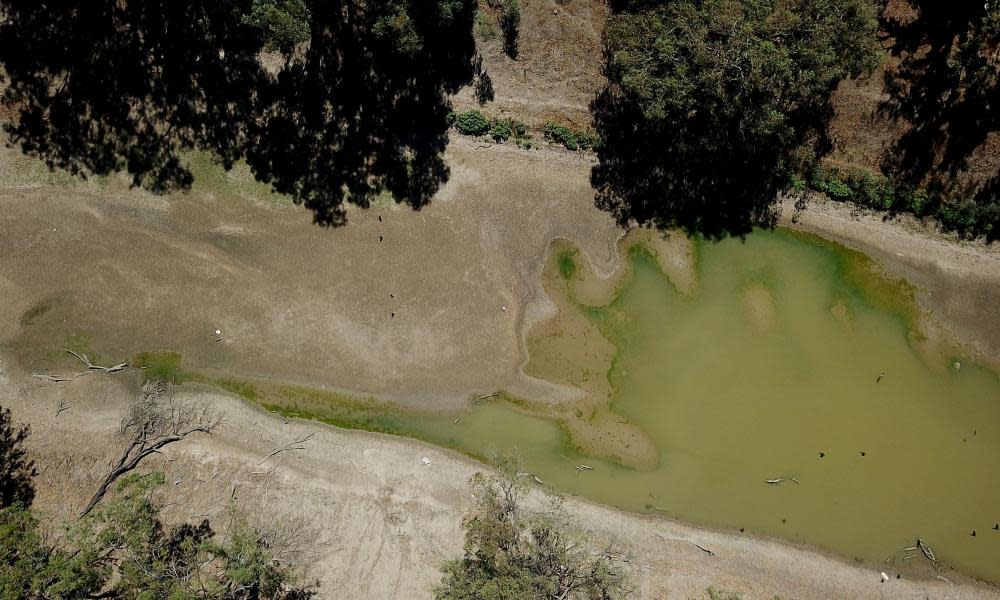NSW exceeds Barwon-Darling water allocations in first year of compliance after regime overhaul

New South Wales has been found to have exceeded its water allocations for 2019-20 in the Barwon-Darling catchment, one of the main cotton-growing areas of the state, raising new questions about the effectiveness of the state’s water enforcement rules.
The Barwon-Darling is the main tributary for the Darling and was the focus of the 2017 Four Corners report which raised allegations of water theft, pumps being tampered with and water users taking more than their allocations.
Related: Water war: rejuvenated Nationals spring Murray-Darling Basin demands on Liberals
It led to a number of reports, prosecutions and an overhaul by NSW of its compliance regime.
But in the first year of compliance reporting, the Murray-Darling Basin Authority found NSW had exceeded what are known as the sustainable diversion limits (SDLs) in three areas – the Barwon-Darling watercourse, the Upper Macquarie alluvium and the Lower Murrumbidgee deep groundwater catchments.
The state claimed there was a “reasonable excuse” for exceeding the limits, and that it was adhering to its draft water resource plans for all three.
The MDBA accepted that as a reasonable and valid explanation for two of the areas, but not for the Barwon Darling.
“The MDBA found that NSW did not operate in a manner fully consistent with the submitted water resource plan in the 2019–20 water year for the Barwon–Darling,” the report said.
All other states were found to be compliant.
The NSW independent MP Justin Field said this was another black mark against the NSW Nationals on water management.
“Communities will be furious that water management has been non-compliant over a period which included the end of the worst drought on record and the first flush event. To have extractions exceeding limits over such a critical period raises serious questions about who benefited from the failures to properly implement water sharing rules.
Related: New South Wales told to go back and try again on Murray-Darling Basin plan submissions
“These findings make it all the more important that downstream targets to protect the environment and communities are included as part of any floodplain harvesting licensing regulations in the Northern Basin, including in the Barwon-Darling.”
The MDBA said NSW had promised to redouble efforts to improve measurement, management and regulation of water resources.
“NSW has not fully implemented its ‘rules for take’ outlined in their draft water resource plan, which includes assessing compliance with their state limits. This is an important rule to ensure actual take does not exceed the allowable limits,” the authority’s Tim Goodes said.
He said NSW had also explained that its model needed further work to enable a better understanding of SDL compliance, and the MDBA accepted that.
“The Barwon-Darling model is 20 years old and is based on diversion data from old meters; it hasn’t been recalibrated to reflect the new meters being rolled out,” Goodes said.
But a spokesperson for the NSW environment department described the issue as “a technical breach and not a result of over extraction”.
Email: sign up for our daily morning briefing newsletter
App: download the free app and never miss the biggest stories, or get our weekend edition for a curated selection of the week's best stories
Social: follow us on YouTube, Facebook, Instagram, Twitter or TikTok
Podcast: listen to our daily episodes on Apple Podcasts, Spotify or search "Full Story" in your favourite app
“We are confident the non-compliance is due to an accounting error and, to our knowledge, no water user took more than they were entitled to under the water sharing plan or their licence conditions,” they said.
“We acknowledge the modelling needs improving. Metering reforms across NSW mean new, more accurate meters are in use in all water systems, which will improve the quality of data being used for modelling.”

 Yahoo News
Yahoo News 
